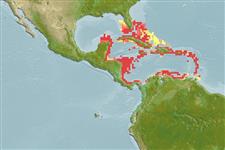Common names from other countries
Environment: milieu / climate zone / depth range / distribution range
экология
морской; пределы глубины 0 - 50 m (Ref. 189). Tropical; 28°N - 7°S, 90°W - 60°W (Ref. 189)
Western Central Atlantic: southern Florida (USA), Cuba, Bahamas, Greater and Lesser Antilles, and Yucatan, Mexico to Venezuela; not in Gulf of Mexico; Trinidad south to Guianas; possibly Brazil.
Size / Вес / Возраст
Maturity: Lm ? range ? - ? cm
Max length : 12.2 cm SL самец/пол неопределен; (Ref. 130066); common length : 10.0 cm TL самец/пол неопределен; (Ref. 5217)
колючие лучи спинного плавника (общее число) : 0; членистые (мягкие) лучи спинного плавника (общее число) : 14 - 15; колючие лучи анального плавника: 0; членистые (мягкие) лучи анального плавника: 19 - 26. Somewhat compressed. Snout pointed, about 3/4 eye diameter; maxilla pointed, long, reaching to hind border of pre-operculum; walkeri-type gill cover canals. Anal fin origin below about midpoint of dorsal fin base. Anus advanced, nearer to pelvic fin tips than to anal fin origin. Silver stripe along flank with a dark line above, expanded over anal fin, about 3/4 eye diameter (Ref. 189). Back gray, top of head iridescent. Melanophores evenly scattered on back, forming a middorsal line, especially rearward (Ref. 7251).
Occurs in coastal waters, forming dense schools. Not entering the mangrove-lined lagoons of the Venezuelan mainland, but is the dominant species of the Los Roques Archipelago off Venezuela and there found as much in the lagoons as outside them. Frequently caught in mixed schools (with A. mitchilli) in the Miami area. Feeds on zooplankton. Ripe females recorded off Florida in June and July. More data needed.
Life cycle and mating behavior
Maturities | размножение | Spawnings | Egg(s) | Fecundities | личинки
Spawn in school (Ref. 205).
Whitehead, P.J.P., G.J. Nelson and T. Wongratana, 1988. FAO Species Catalogue. Vol. 7. Clupeoid fishes of the world (Suborder Clupeoidei). An annotated and illustrated catalogue of the herrings, sardines, pilchards, sprats, shads, anchovies and wolf-herrings. FAO Fish. Synop. 125(7/2):305-579. Rome: FAO. (Ref. 189)
Статус Красного Списка МСОП (Ref. 130435)
CITES (Ref. 128078)
Not Evaluated
Угроза для людей
Harmless
Использование человеком
рыболовство: рыболовство как средство для существования; наживка: usually
дополнительная информация
инструменты
Специальные отчеты
Скачать в формате XML
ресурсы в Интернет
Estimates based on models
Preferred temperature (Ref.
115969): 25.1 - 28.1, mean 27.5 (based on 112 cells).
Phylogenetic diversity index (Ref.
82804): PD
50 = 0.5000 [Uniqueness, from 0.5 = low to 2.0 = high].
Bayesian length-weight: a=0.00513 (0.00232 - 0.01135), b=3.14 (2.96 - 3.32), in cm Total Length, based on LWR estimates for this Genus-body shape (Ref.
93245).
Trophic level (Ref.
69278): 3.4 ±0.45 se; based on food items.
устойчивость к внешним воздействиям (Ref.
120179): высокий, минимальное время удвоения популяции до 15 месяцев (Preliminary K or Fecundity.).
Fishing Vulnerability (Ref.
59153): Low vulnerability (10 of 100).
